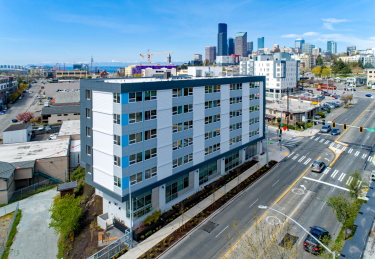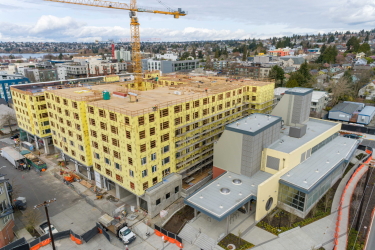|
Subscribe / Renew |
|
|
Contact Us |
|
| ► Subscribe to our Free Weekly Newsletter | |
| home | Welcome, sign in or click here to subscribe. | login |
Construction
| |

June 10, 2021
Walsh launches 5-year plan with focus on diversity and community building
Special to the Journal
As Walsh Construction Co. celebrates its 60th year, company leaders say they are looking to the next five years with a focus on diversity and community building.
“We are grateful for our talented team and proud of our values-driven partnerships with clients that have been forged over the past six decades,” said Walsh Construction President Bill Reid. “The success and longevity of our business is due to these long-term relationships with clients who are consistently pleased with our performance and excited to work with us on the next project.”
Last year, the firm launched a new 5-year strategic plan. The Vision 2025 strategy, according to Reid, “includes an emphasis on building communities and empowering people.”
“Walsh's commitment to empowerment and diversity in construction is a continual, integral part of how we do business,” he said.
Along those lines, Reid said more than 40% of Walsh's management staff are women and people of color, the result of an effort to develop a diverse workforce.
Walsh launched its 5-year plan during a year of unprecedented disruptions from the COVID-19 pandemic. While the initial jolt of the pandemic briefly interrupted the firm's construction schedule, Reid said teams were able to bounce back quickly.
Reid said Walsh was fortunate to only have a brief shutdown on its projects in the early stages of the pandemic because eight of 10 active Walsh projects were deemed as high priority, essential affordable housing jobs, Reid said.
“Otherwise, we have been able to operate at nearly 100% capacity without any layoffs or significant project delays,” he said. “While we can say that the past 14 months were extremely stressful with jobsites managing rapidly changing regulations, misinformation, work-life balance and mental health challenges — our jobsite management teams and COVID-19 task force came together in a remarkable manner to provide proactive guidance and timely responses to COVID-related issues.”
He added that Walsh experienced fewer COVID-19 cases compared to the industry average and was able to keep its projects on or ahead of schedule to deliver affordable and senior housing.
While COVID-19 safety prevention measures paid off for Walsh in terms of staying on schedule with its projects, an unforeseen new challenge awaited: inflation in material costs.
Reid said material pricing and availability has been an issue on several current and upcoming projects. Most notably, lumber shortages and high prices proved challenging.
“As framing was scheduled to commence last fall on several significant projects, lumber pricing was escalating at an unprecedented pace,” he said. “In the face of this challenge, we implemented a variety of solutions to manage the situation to protect our clients' interests. Material substitutions, advance purchasing, increased labor efficiency and alternate supply sources have all been employed to combat the pricing and availability issues. As a result, we have experienced no delays due to this problem and have limited our clients' liability to a fraction of the potential impact that was projected when the problem first surfaced.”
Even with COVID-19 challenges and materials shortages, Reid said Walsh continued its focus on building affordable housing. Despite what he called “layers of complexity in financing, public process and site conditions” that can come with affordable housing projects.
“Walsh has been serving the affordable housing community throughout our 60-year history, having completed over 700 projects and created or renovated over 56,000 affordable homes throughout Oregon and Washington,” he said. “In the Washington region in 2020, we delivered over 2,000 homes to 11 mission-driven clients, many of them located along the existing or future Sound Transit light rail corridor.”
He added that, in the first quarter of this year, Walsh's work included the renovation of two homeless shelter spaces in Olympia and Seattle to provide healthier spaces in response to the COVID-19 pandemic, and Walsh is currently building two mixed-use supportive housing projects in central Seattle that will provide more than 250 new homes and public health services to individuals transitioning out of homelessness. Walsh has also worked on the renovation of the historic Frye Hotel in Pioneer Square for the Low Income Housing Institute; and the construction of a 250-apartment mixed-use development for Bellwether Housing and Mercy Housing Northwest at the Roosevelt Sound Transit light rail station.
For all project types, Reid said Walsh takes “an R&D approach to improving the durability, energy-efficiency and cost-efficiency of our multifamily projects, especially for our affordable housing clients.”
To address building durability and envelope integrity, Reid said Walsh developed a quality assurance/quality control program in the early 2000s — staffed by architects with a background in building science. Walsh completed a LEED platinum project for Community Roots Housing in 2020.
“This program has expanded to include energy efficiency with a particular focus on building air tightness,” he said. “Our methods have been refined such that we are able to greatly exceed air tightness requirements in whole building tests conducted at project completion. These efforts result in buildings that are more energy efficient and easier to maintain to the benefit of our affordable housing clients and residents.”
Reid said that Walsh, since its inception in 1961, “has been a family of hardworking and community-minded builders.” Reid started at Walsh in 1979 as a laborer, working summers during college.
Much of his career has been focused on the creation of affordable housing, helping to forge decades-long relationships with Providence Health & Services, Low Income Housing Institute, and the Tacoma and Seattle housing authorities.
“We look forward to continuing to meet the building needs of nonprofit organizations, public agencies, senior housing providers and other values-driven owners to align with efforts to accommodate the remarkable growth of our region,” Reid said. “We will continue to explore opportunities to add value to our clients' projects through continued development of our cost-efficient design and construction initiative, as well as efforts to increase the scale of projects and improve environmental outcomes.”
Previous columns:
- Why every new office should be a Living Building, 06-03-2021
- Massive mural is a nod to Passive House design for East Pike apartment building, 05-27-2021
- Buttigieg reinstates local hiring program for public works construction projects, 05-20-2021
- King County creates more opportunities for MWBE design and construction contractors, 05-13-2021
- Will 3D printing solve the housing shortage?, 05-06-2021
- It's a wrap: County turns old Harbor Island flour mill into Hollywood-style sound stage, 04-29-2021
- 2 years after devastating fire, Notre Dame gets ready for actual restoration phase, 04-22-2021
- Fort Worden transformed to ‘make art, not war', 04-15-2021




